Motorola Droid RAZR Review - A Better Clad Bionic
by Brian Klug on December 16, 2011 2:01 AM EST- Posted in
- Smartphones
- Droid
- LTE
- 4G
- Motorola
- Android
- Mobile
- Droid RAZR
- motorola droid RAZR
Battery Life
I still think that when we’re reviewing a 4G LTE device that battery life is the main concern, and with a sealed internal battery this is an even more relevant point than it would be otherwise. I started the Bionic review out with a look at battery life first, and think the same approach makes sense for the RAZR. As I mentioned before, the RAZR has a 6.7 Whr internal battery which makes use of Motorola’s new higher voltage Li-Ion chemistry, just like we saw in the Bionic.
Motorola also sent us all the goodies to go along with the RAZR, including the Lapdock 100, car windshield mount, VGA adapter, and an extra external 6.9 Whr battery. More on those accessories in a moment, for now let's just talk about the battery.
Since the battery for the RAZR is sealed inside, there’s no way to go the traditional extended battery route, and thus this external battery which connects using microUSB is the only viable option to extend your electron tank. The external battery charges using a microUSB port on its side and can charge up to two devices at the same time.
One using the microUSB connector on a rubberized cable that folds into the opposite side, the other using the female USB type A connector at the top. I used the external charger to juice up the RAZR and another device at the same time to much success. Of course, using a big external battery to simultaneously charge a battery and power the RAZR incurs some overhead.
To measure how good the RAZR is at sipping juice, we turned to our standard suite of battery life tests. The first loads through a dozen or so pages over cellular data and WiFi with the display constantly on and set to a brightness of 200 nits using the stock browser.

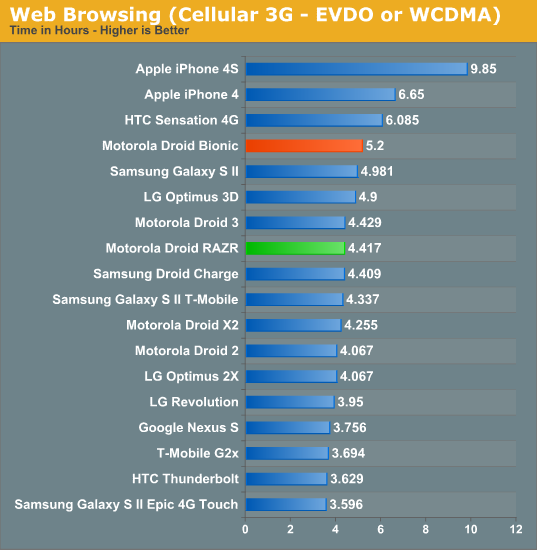
In the cellular browsing department, the RAZR unsurprisingly performs very close to the Bionic, but comes in just behind in spite of having a slightly larger battery. It’s pretty easy to point out the sources of increased battery drain on the RAZR versus Bionic, and that’s both inclusion of AMOLED (virtually all the webpages in our testing suite have white backgrounds), and a higher CPU clock, though admittedly most of the time the CPU is in an idle state. The other parts of the equation again remain the same - the RAZR has the same cellular basebands and a similar family PMIC (power management IC).
Using the external battery gives you another 2.5 hours of charge in our LTE test, which isn’t a doubling, but still a respectable boost. As predicted, you end up losing some of that charge on the external battery to overhead, but it isn’t dramatic. I didn’t measure how much of a gain using the external battery on EVDO nets you, but you can safely bet the same 1.83 multiplier applies.
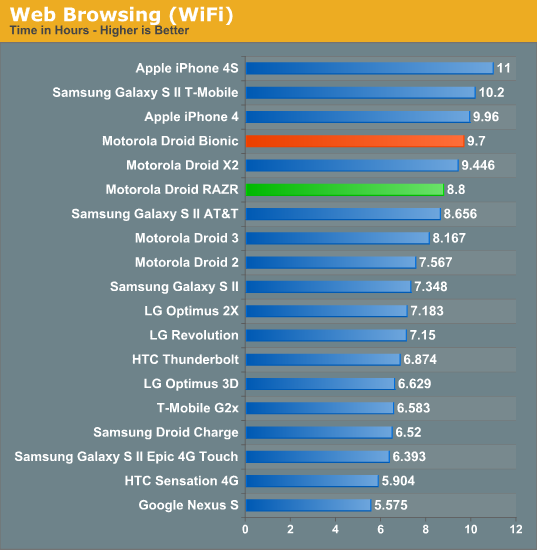
This trend where the RAZR lags the Bionic in our battery life testing carries on to the WiFi web browsing test as well - the two include the same TI WL1285 WLAN combo chip.
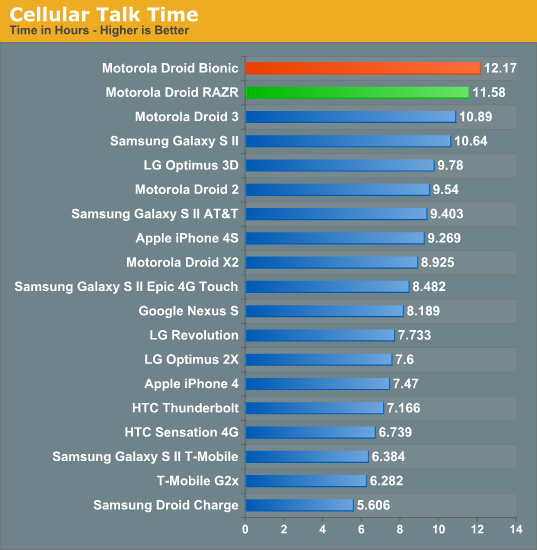
Call testing time likewise puts the RAZR just behind the Bionic. As a reminder, calls on Verizon still happen over 1x on the MDM6600.
I’m starting to put more stock in our WiFi hotspot battery life test, which has four of our normal page loading tabs open and a 128 kbps MP3 streaming radio instance from smoothbeats.com going. This keeps the baseband and WiFi stacks up and also relies on the CPU for routing network traffic through a NAT, and the display is off.
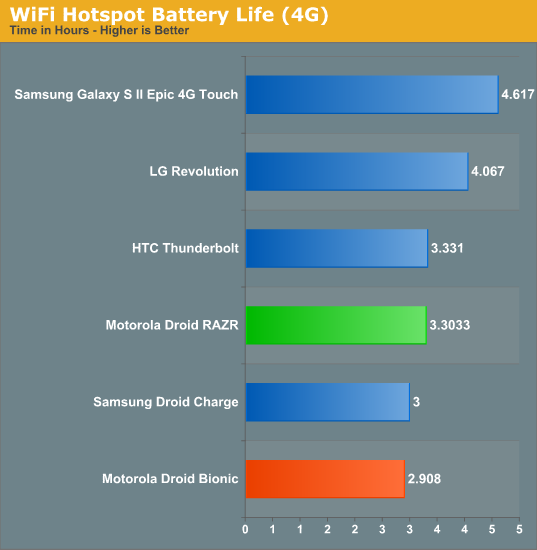
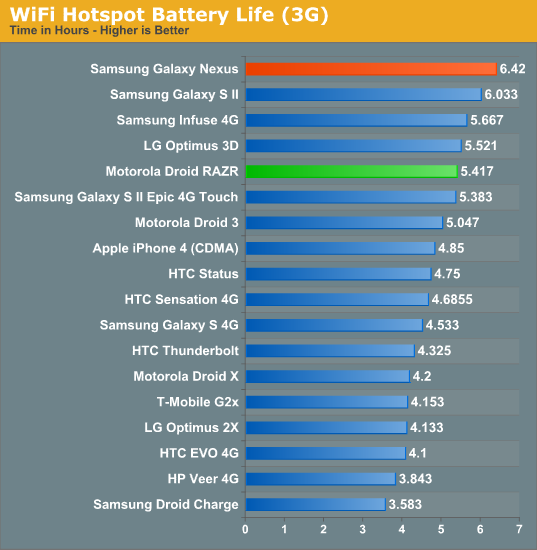
Here the RAZR surprisingly ousts the Bionic (despite testing being done in the exact same location and signal characteristics) by a little over a half hour.
So in the battery department there isn’t much to talk about with respect to the RAZR except to note that it’s very comparable to the Bionic owing to - again - being based on essentially the same hardware platform. The difference we do see is largely a result of adding a Super AMOLED Advanced display and higher peak CPU clock.
If you’re not near a charger or unwilling to go for the external battery, our guidance remains much the same as it did when we first started looking closely at 4G LTE handsets - wait for 28nm SoCs and basebands in 2012. That said, it’s absolutely possible to make it through a day with the internal battery, it just depends on what your daily use patterns are.



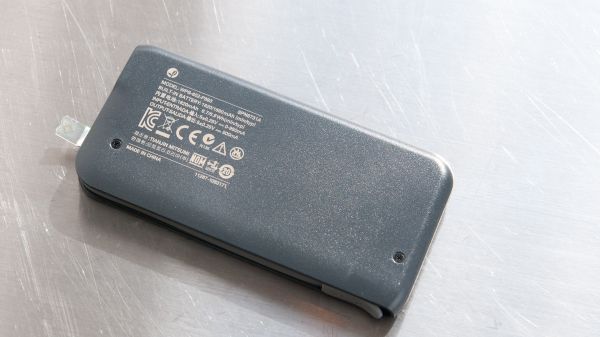














76 Comments
View All Comments
secretmanofagent - Friday, December 16, 2011 - link
Brian, have you seen any data connectivity issues that plague the Droid Bionic on the RAZR? It was something Verizon confirmed was a known issue (there was a patch released yesterday but don't know if that addressed that issue) and was happening to me quite frequently. I managed to move from the Bionic to the RAZR because of Verizon, and I've seen some hiccups that looked similar to the Bionic issue (it's the same LTE and CDMA baseband).flyfishin69 - Sunday, December 18, 2011 - link
I to am an (almost) former owner of the Bionic. The phone will loose all cellular data after coming in contact with 4g and trying to negotiate back to 3g. And especially in the Hagerstown Md. Area where verizon has no 3g service only 4. I would always find the bionic lifeless. I spoke with a verizon rep and he is sending my Razr tomm. Are we seeing these same problems in the Razr?Nfarce - Sunday, December 18, 2011 - link
Hmmm. I have had the Bionic for three months, since it first came out, and never had a single issue. Here in the greater metro Atlanta area I go between 4G and 3G all the time depending on how far outside the city. I have roamed all over the Southeast while driving and never had a problem either.Sounds to me like you just got a lemon.
secretmanofagent - Monday, December 19, 2011 - link
Nope, they weren't lemons. Check out Verizon's update:http://www.droid-life.com/2011/12/08/droid-bionic-...
Big one is "Improved stability of data connections on 3G and 4G". Worst part for those who still have it: Verizon says it will "help alleviate" the problem.
You're only one of three people that I know of who have said they weren't affected, out of about 10-15. Consider yourself lucky.
Nfarce - Tuesday, December 20, 2011 - link
Yes I guess I was lucky. I actually had no idea this update was even coming until trying to make a call Thursday evening last week. About the only gripe I had of the phone was the crappy autofocus problem. It seems to be a lot better now. I surmise the 3G/4G issue depended at least to some extent what region of the nation you lived in. Two co-workers have the phone (one got a RAZR and gave the Bionic to his wife) and neither reported problems either.secretmanofagent - Monday, December 19, 2011 - link
I've seen a couple times like what I had seen with the Bionic, but only momentary losses.loribeth - Tuesday, December 27, 2011 - link
Both 4G and 3G data drops for me. I live 30 miles north of Indy, which is 3G, but work in 4G territory. The upgrade has not helped and only created other buggy issues.LoneWolf15 - Friday, December 16, 2011 - link
I just did a lot of research before picking up a phone this week. The RAZR was among the half a dozen smartphones I considered --until I picked it up.I have relatively large hands with long fingers, and the phone is STILL too wide to comfortably hold in the hand. It's actually wider than the Droid Bionic (which I did purchase), and its relative thin-ness makes it less comfortable in the hand rather than more. Making a slightly thicker phone, and using that extra thickness to increase battery size would have actually made it more comfortable.
Of course, that would make the phone a Droid Bionic. Which is now $100 cheaper due to the RAZR coming out, so you can save $100 and get a phone that's every bit as capable, with more battery options. They also released a major update to the Bionic this week that squashed a ton of bugs.
At the $299 price, I'd probably look at the Galaxy Nexus or the HTC Rezound --not the RAZR. The Bionic is a much better value if you want a Motorola phone. So far, I'm happy with mine.
Nfarce - Sunday, December 18, 2011 - link
Yep, I like the feel of the Bionic more than the RAZR. I got the thin rubber-like enclosing protective case and it helps even more on the grip. My friend's RAZR feels too fragile and I'd definitely be more worried about dropping it. Thinner isn't always better to some of us.I would have waited for a price drop on the Bionic, but since my older Droid died and I was going month to month without a contract, I had to buy a new phone like yesterday, and in September, the Bionic was the best. Verizon threw in $70 worth of free accessories for me at the full $299 purchase price, so that eased the pain a little (case, car charger, screen protector).
JonnyDough - Saturday, December 17, 2011 - link
"Thankfully holding volume down and power/lock for 10 seconds reboots the device even when the device is totally unresponsive (which I did in fact encounter once)."Something I often encountered on my original DROID and also on my Thunderbolt 4G LTE. I'm honestly a bit sick of the issues with Android. You would think they would fix them. My phone has been known to do some really quirky stuff. From calling people on contact lists from that others who share a phone plan with me have on THEIR phones (the people my phone called are NOT on my phone!), to random reboots, SMS's not sending, and the 3G/4G service acting dodgy, even though I may not leave the house for awhile. Those are just a few of the issues I have suffered through over the last 2 years.